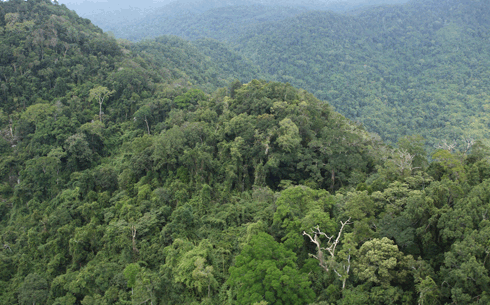
|
Published: 28 May 2012
Cambodia urged to choose sustainable development
Cambodia is at a point in its development where it could choose to embrace low-carbon development and position itself as a global leader in the green economy, or continue along an unsustainable trajectory, according to a senior scientist from Conservation International.

|
|
Cambodia’s Cardamom Mountains: ‘an ideal laboratory for envisioning a development paradigm that would lead to a low-carbon economy’, according to a new book. Credit:
© Allan Michaud/CI
|
In his book, Cardamom Conundrum: Reconciling development and conservation in the Kingdom of Cambodia, Conservation International’s (CI) Dr Timothy Killeen explains that Cambodia’s ‘conundrum’ arises from two widely held and conflicting assumptions: the pathway to a modern economy requires exploiting and monetising natural resources; while its long-term prosperity depends on the conservation of those same resources.
Dr Killeen encourages policy makers, investors and communities to shed commonly held beliefs in the idea of either/or tradeoffs involving development and conservation. These beliefs have historically viewed conservation as a barrier to productivity and economic growth, and development as an automatic threat to nature.
This, says Dr Killeen, misses the big picture. Conservation and development are not only compatible, but are strategically linked.
His proposal is that, through an evaluation of opportunities in the still-pristine forests of the Cardamom Mountains and surrounding landscapes, Cambodia can choose to wisely manage renewable natural resources to facilitate economic growth.
‘Balancing the Khmer people’s legitimate aspirations for development and the equally urgent need to conserve the nation’s vital natural heritage is vital to the future state of Cambodia,’ says Dr Killeen.
‘The conservation of natural ecosystems is beneficial to the national economy... the wise management of these natural assets can increase Cambodia’s economic growth in the short, medium and long term.’
Resolving the ‘Cardamom conundrum’ requires an economic model that provides robust growth and alleviates poverty through innovations linked to emerging low carbon development opportunities.
Dr Killeen selected the Greater Cardamom Region – which spans the mountainous regions of Cambodia between the Tonle Sap and Gulf of Thailand – as an ideal laboratory for envisioning a development paradigm that would lead to a low-carbon economy. Its landscapes and populations are typical of the country as a whole.
The future of the Greater Cardamom Region – and Cambodia in general – depends on how the environmental and social impacts of development (hydropower, forest products, agriculture and tourism) are managed. This in turn depends on the value put on ecosystem services provided by forest, freshwater and coastal ecosystems.
Dr Killeen said Cambodia can build a low-carbon future on sustainable forest conservation and management; agricultural diversification and intensification; fisheries and aquaculture; and a diversified and green tourist sector. Equally important is the need to pursue low-emission development strategies in the energy, transportation and industrial sectors.
‘If Cambodia can resolve this, they will become a world leader and model for creating a healthy green economy that will provide current and future generations with a sustainable prosperous future’ he concludes.
Source: Conservation International



